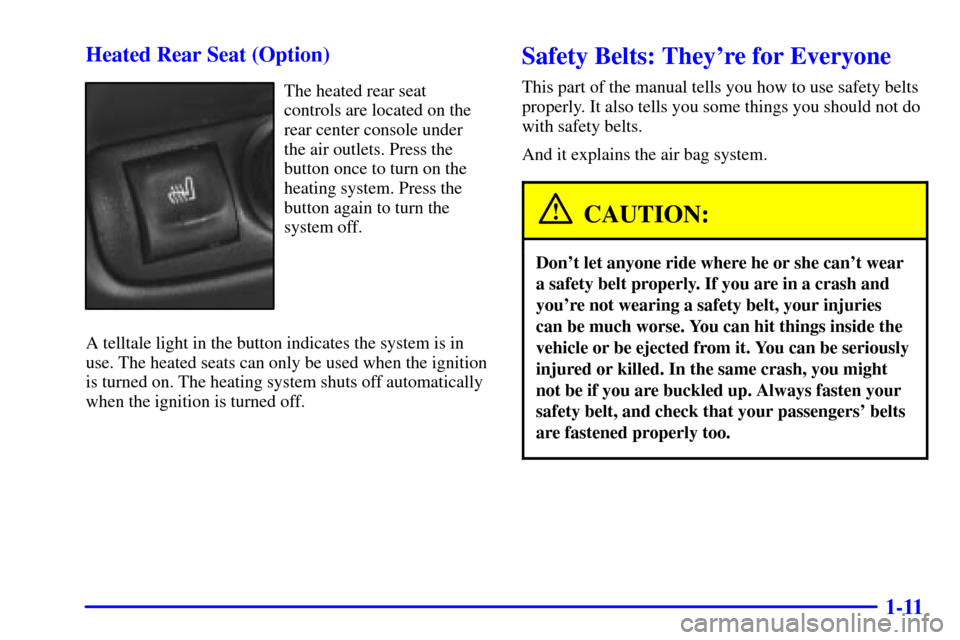Page 17 of 321
1-5 Heated Front Seats (Option)
The controls for the heated
front seats are located next
to the climate controls on
either side of the center
console. Turning the driver
or passenger side control
counterclockwise from the
off position activates the
heated seat.
The control can be adjusted to one of five heat settings,
numbered 1 through 5, with 1 being the lowest setting
and 5 being the highest setting.An indicator light in the control reminds you that the
heating system is in use. The heated seats can only be
used when the ignition is turned on.
To turn the heated seat off, turn the control clockwise to
the off position.
Reclining Front Seatbacks
The power control is
located on the outboard
side of each front seatback.
Press the control forward
or rearward to adjust
the seatback.
Page 23 of 321

1-11 Heated Rear Seat (Option)
The heated rear seat
controls are located on the
rear center console under
the air outlets. Press the
button once to turn on the
heating system. Press the
button again to turn the
system off.
A telltale light in the button indicates the system is in
use. The heated seats can only be used when the ignition
is turned on. The heating system shuts off automatically
when the ignition is turned off.
Safety Belts: They're for Everyone
This part of the manual tells you how to use safety belts
properly. It also tells you some things you should not do
with safety belts.
And it explains the air bag system.
CAUTION:
Don't let anyone ride where he or she can't wear
a safety belt properly. If you are in a crash and
you're not wearing a safety belt, your injuries
can be much worse. You can hit things inside the
vehicle or be ejected from it. You can be seriously
injured or killed. In the same crash, you might
not be if you are buckled up. Always fasten your
safety belt, and check that your passengers' belts
are fastened properly too.
Page 45 of 321

1-33 Servicing Your Air Bag-Equipped Vehicle
Air bags affect how your vehicle should be serviced.
There are parts of the air bag systems in several places
around your vehicle. Your dealer and the service manual
have information about servicing your vehicle and the
air bag systems. To purchase a service manual, see
ªService and Owner Publicationsº in the Index.
CAUTION:
For up to 10 seconds after the ignition key is
turned off and the battery is disconnected, an
air bag can still inflate during improper service.
You can be injured if you are close to an air bag
when it inflates. Avoid wires wrapped with
yellow felt, wires wrapped with yellow tape or
yellow connectors. They are probably part of
the air bag systems. Be sure to follow proper
service procedures, and make sure the person
performing work for you is qualified to do so.
The air bag systems do not need regular maintenance.
Safety Belt Pretensioners
Your vehicle has safety belt pretensioners. You'll find
them on the buckle end of the safety belts for the
driver and right front passenger. They help the safety
belts reduce a person's forward movement in a
moderate to severe crash in which the front of the
vehicle hits something.
Pretensioners work only once. If they activate in a crash,
you'll need to get new ones, and probably other new
parts for your safety belt system. See ªReplacing
Restraint System Parts After a Crashº in the Index.
Rear Seat Passengers
It's very important for rear seat passengers to buckle up!
Accident statistics show that unbelted people in the rear
seat are hurt more often in crashes than those who are
wearing safety belts.
Rear passengers who aren't safety belted can be thrown
out of the vehicle in a crash. And they can strike others
in the vehicle who are wearing safety belts.
Page 66 of 321

2-
2-1
Section 2 Features and Controls
Here you can learn about the many standard and optional features on your vehicle, and information on starting,
shifting and braking. Also explained are the instrument panel and the warning systems that tell you if everything is
working properly
-- and what to do if you have a problem.
2
- 2 Keys
2
- 4 Door Locks
2
- 7 Remote Keyless Entry System (RKE)
2
- 11 Trunk
2
- 12 Theft
2
- 13 Theft-Deterrent System (Option)
2
- 15 Immobilizer
2
- 16 New VehicleªBreak-Inº
2
- 16 Ignition Positions
2
- 18 Starting Your Engine
2
- 19 Engine Coolant Heater (If Equipped)
2
- 21 Automatic Transmission Operation
2
- 26 Parking Brake
2
- 27 Shifting Into PARK (P)
2
- 29 Shifting Out of PARK (P)
2
- 30 Parking Over Things that Burn2
- 31 Engine Exhaust
2
- 31 Running Your Engine While You're Parked
2
- 32 Windows
2
- 34 Horn
2
- 34 Tilt Wheel
2
- 35 Turn Signal/Multifunction Lever
2
- 41 Exterior Lamps
2
- 47 Interior Lamps
2
- 48 Mirrors
2
- 50 Storage Compartments
2
- 53 OnStar� System (If Equipped)
2
- 54 Sunroof (Option)
2
- 58 HomeLink� Transmitter (If Equipped)
2
- 62 The Instrument Panel -- Your
Information System
2
- 66 Warning Lights, Gages and Indicators
Page 67 of 321
2-2
Keys
CAUTION:
Leaving children in a vehicle with the ignition
key is dangerous for many reasons. A child or
others could be badly injured or even killed.
They could operate the power windows or
other controls or even make the vehicle move.
Don't leave the keys in a vehicle with children.
Page 68 of 321
2-3
One key is used for the
ignition, the doors and
all other locks. (Note that
there is no lock cylinder
for the trunk or the
passenger's door.)
Your vehicle comes with a spare key. This key does
not have an immobilizer pellet in it; however, it will still
unlock your vehicle's doors. Because of the key's flat
shape, it can be stored in your wallet.If you've lost your keys or need to have a new one
made, you will have to contact your dealer for the
correct key code.
NOTICE:
Your vehicle has a number of new features that
can help prevent theft. You can have a lot of
trouble getting into your vehicle if you ever lock
your keys inside and you may have to damage
your vehicle to get in. Be sure you have extra keys.
Page 70 of 321

2-5 Power Door Locks
Push the side of the
power door lock switch
with the lock symbol to
lock all the doors.
Push the side of the switch with the unlock symbol to
unlock all the doors.
Automatic Door Locks
Close the doors and turn on the ignition. Every time you
move the shift lever out of PARK (P), all of the doors
will lock. The doors will also unlock every time you
stop the vehicle and move the shift lever into PARK (P).
If someone needs to get out while your vehicle is not in
PARK (P), have that person use the manual or power
door lock. When the door is closed again, it will not lock
automatically. Use the manual or power lock to lock the
door again.
Programmable Automatic Door Locks
Each remote keyless entry transmitter supplied with
your vehicle can be programmed to suit each driver's
door lock preference. The two remote keyless entry
transmitters are identified on the back with either a ª1º or
a ª2º. Each transmitter can be programmed separately.
The automatic door locks can be programmed (using the
remote keyless entry transmitter) for various lock and
unlock options.
With the ignition on, the transmission in PARK (P)
and the brake pedal pressed down, you are now ready
to begin programming.
Page 72 of 321

2-7
When you want to open a rear door when the security
lock is on:
1. Unlock the door from the inside.
2. Then open the door from the outside.
To cancel the rear door lock:
1. Unlock the door from the inside and open the door
from the outside.
2. Move the lever all the way up.
3. Do the same for the other rear door.
The rear door locks will now work normally.
Anti-Lockout Feature
Leaving your key in the ignition with a door open will
prevent locking of the doors with either the power door
lock switches or the remote keyless entry transmitter.
It is always recommended that you remove the ignition
key when locking your vehicle.
The anti
-lockout feature can be overridden by holding
the power door lock switch for three seconds or longer.
Leaving Your Vehicle
If you are leaving your vehicle, open the door, set the
locks from the inside, get out and close the door.
Remote Keyless Entry System (RKE)
If your vehicle has this feature, you can lock and unlock
your doors or unlock your trunk from about 3 feet (1 m)
up to 30 feet (9 m) away using the remote keyless entry
transmitter supplied with your vehicle.
Your keyless entry system operates on a radio frequency
subject to Federal Communications Commission (FCC)
Rules and with Industry Canada.
This device complies with Part 15 of the FCC Rules.
Operation is subject to the following two conditions:
(1) this device may not cause harmful interference,
and (2) this device must accept any interference
received, including interference that may cause
undesired operation.
This device complies with RSS
-210 of Industry Canada.
Operation is subject to the following two conditions:
(1) this device may not cause interference, and (2) this
device must accept any interference received, including
interference that may cause undesired operation of
the device.
Changes or modifications to this system by other than
an authorized service facility could void authorization to
use this equipment.